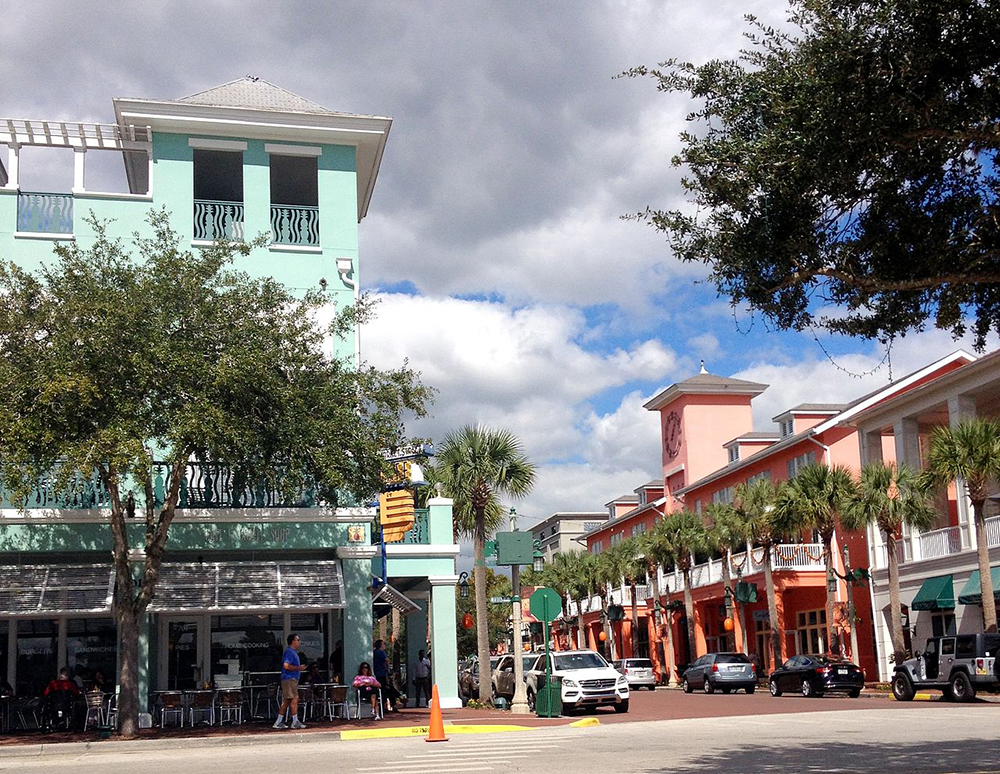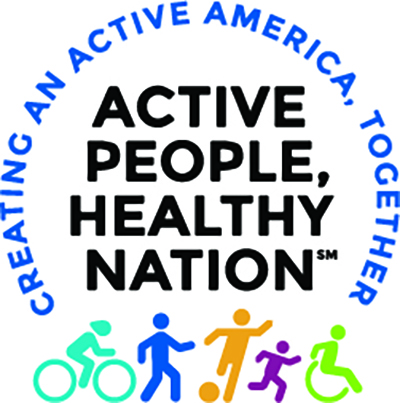Everyday Destinations
Encouraging Physical Activity Through Traditional Neighborhood Development

This blog post is part of the Everyday Destinations series, which focuses on increasing physical activity in small and rural communities through everyday destinations.
Traditional neighborhood development (TND), or village-style development, is a land-use approach that provides a mix of land uses and housing types connected by pedestrian-friendly streets in a compact setting. (Chester County Planning Commission n.d., National League of Cities n.d.). TND resembles human settlements before automobile-centric development.
This approach encourages multimodal connectivity (e.g., walking, biking, taking transit) to destinations in new developments or as part of infill development activities. TND also offers opportunities to restore and enhance social connectedness and increase local vibrancy. It integrates access to community destinations by increasing and diversifying housing stock; boosting access to central public areas, such as plazas and parks, as well as civic spaces, such as cultural venues and community institutions; and providing space for commercial activity.
As a result, TND can support economic development, limit environmental impacts, enhance social cohesion, and provide benefits to community members, including health improvements from increased walkability and social connections.
Equity Considerations
Ensuring equitable access to TND benefits often includes integrating a variety of housing options to appeal to or suit all housing needs. Because of increased access to destinations and amenities, residential units in TNDs can be highly desirable, which can increase housing prices. Without locally tailored measures in place to preserve affordability, community members with lower incomes may be displaced or excluded (Center for Land Use Education 2005).
Communities can carefully consider tools to determine a strategy mix that fits local contexts and helps existing renters and homeowners who wish to remain in the community where TND is being applied.
In such projects, providing housing options at different price points can increase accessibility for community members at different income levels (Center for Land Use Education 2005). Communities can require or incentivize affordable housing options to ensure that residents of varying incomes have opportunities to benefit from TND.

Traditional Neighborhood Development: Celebration, Florida, is an example of a community that implements traditional neighborhood development strategies and encourages walkability. Source: Simonhardt93 (CC BY-SA 4.0). Celebration Market Street.
Connection to Small and Rural Towns
In small and rural towns, TND may be used to expand or increase vibrancy in town centers while retaining rural character (Commonwealth of Massachusetts n.d.; Mishkovsky et al. 2010).
TND reduces sprawl and encourages clustering, making it a particularly effective approach in small and rural communities that aim to revitalize community spaces and manage the demands of growing populations. It encourages residents to use sidewalks and active transportation options to access nearby destinations by increasing roadway connections, making buildings accessible from pedestrian routes, and reducing distances between destinations.
Areas selected for TND can implement customized site design standards to fit community character, which is often a priority in small and rural towns.
When TND is applied to greenfield development, it can reduce development pressures on open space by encouraging thoughtful, compact development that is consistent with community goals for preserving natural areas and rural quality of life.
TND, when combined with the transfer of development rights programs, reduces development pressures on privately owned open space by compensating private owners for preserving natural areas, agricultural land, and other open spaces, while directing development toward designated growth areas.
Case Example: Somerville, Massachusetts
The City of Somerville, Massachusetts, adopted the Union Square Neighborhood Plan in 2016, which sought to improve community conditions in alignment with SomerVision: Somerville's Comprehensive Plan 2010–2030.
Informed by insights gathered from community engagement, the plan seeks to strengthen TND through street improvements, pedestrian amenities, and an expansion of available housing and commercial space. It explicitly describes the importance of destination locations, such as workplaces and retail, to promote a walkable environment.
While the community is still in the early stages of implementing the plan (the plan's timeframe is 20–30 years), it is already seeing benefits. For example, the Community Design Team, composed of Somerville residents, has gathered input from community members about a redesign of the Union Square Neighborhood Plaza to help the city "create spaces where people of all ages and backgrounds can hang out" (Levavi 2021).
Other partners engaged in redesigning Union Square to better align with the neighborhood plan include the Public Space and Urban Forestry Division team and local business leaders (Levavi 2021).
Strategic Points of Intervention
Practitioners have a variety of options to help their communities implement traditional neighborhood developments. This section provides a non-exhaustive list of strategies that professionals with the ability to influence the built environment can use to improve access to everyday destinations.
Collaboration between these professionals and public health is crucial, as public health professionals can support planning approaches and engage partners, but may not have the authority to implement some of the strategies identified below.
This blog encourages communication and engagement between public health and planners to discuss approaches that might be applicable in their community. For more information on the role of public health professionals in helping implement these strategies. For more information on other partners that play a role in implementing the growth area identification approach.
The following list of strategies can help professionals from different sectors come together and implement planning approaches that support a mix of accessible everyday destinations. Community engagement is crucial throughout every step of implementing the strategies below.
Planners and public health professionals can collaborate to create equitable engagement to collect and act on community needs. Communities should select the strategies based on their context and constraints. The links at the end of actions provide more guidance materials and examples from small and rural towns across the country.
Plan Making
- Integrate TND principles into comprehensive plans to encourage connected infill development (Chester County Planning Commission n.d.). These principles can be elevated to address community-identified priorities while drafting plan updates.
- Balance historic preservation and new mixed-use development to strengthen community aesthetic preferences, housing options, and community history (Missoula 2020).
- Identify potential areas suitable for TND by mapping community features and sites available for development (Chester County Planning Commission n.d.) and identifying community trends, such as population growth and economic activity, that may influence future developments (EPA 2015; WeConserve PA n.d.).
- Include TND along with affordable housing goals to encourage diversity in the housing stock (Flagstaff 2014). This approach can be presented by planners as an option to advance community vision and goals.
Regulations and Incentives
- Review existing zoning and subdivision ordinances to identify how to reduce barriers to TND, such as creating smaller lots and permitting greater density (Chester County Planning Commission n.d.).
- Ensure TND ordinance provisions relate to community vision and goals. Routinely review and update ordinances to ensure they reflect community priorities (WeConserve PA n.d.).
- Identify which regulatory approach for implementing TND requirements is most appropriate for a community, such as zoning districts, overlay zones, or a modified planned unit development (Center for Land Use Education 2005; EPA 2015).
- Draft and adopt a transfer of development rights program in conjunction with TND with the support of a land-use planner (WeConserve PA n.d.). This strategy can be applied in areas interested in a market-based approach to open space preservation.
- Adopt design guidelines that advance community character (Chester County Planning Commission n.d.).
- Consider whether a form-based code can help advance TND goals (Missoula County and City of Missoula 2020).
Development work
- Guide developers seeking to implement TND projects and owners interested in retrofitting existing buildings using TND principles through design guidelines, development review, and public-private partnerships that advance TND. Guidance can include design elements and recommended practices to create successful TNDs (Lowell 2006).
- Provide development review options for developers, such as pre-application meetings, to align proposed developments with TND principles. Planning and development services departments can offer to meet with developers as part of the development review process.
Potential Partnerships
Communities have active organizations, leaders, and professionals that can contribute to implementing the strategies provided in the previous section.
Built environment and public health professionals should consider, and if applicable, reach out to the following groups to discuss traditional neighborhood developments. These groups can also recommend other organizations that may be able to collaborate.
The following non-exhaustive list of partners offers potential starting points — there may be more partners to consider, depending on the community.
- Collaborate with community members to determine desirable TND design elements, housing mix, and mix of uses.
- Connect with transit agencies to identify opportunities to co-locate TND projects with multimodal transportation networks.
- Partner with affordable housing agencies to identify opportunities to increase access to housing in TND projects.
- Identify local businesses and business organizations interested in participating in TND.
- Guide developers to encourage access to destinations and affordable housing options in TND projects.
- Identify sites suitable for TND with input on infrastructure from public works departments and ensure that developments are compact and capable of allowing for necessary functions, such as snow removal, mail delivery, and maintenance.
- Determine whether there are opportunities for local institutions to serve as anchors for public spaces within TNDs.
- Coordinate with regional planning agencies to identify options and recommendations that support smaller and rural municipalities interested in developing TNDs.
We are interested in case examples that support physical activity through everyday destinations in communities with a population of less than 20,000 people. If you are aware of such communities, please share their stories with us at activepeople@cdc.gov. By directing us to such articles, you can help other small and rural communities become more active and healthier.
References
Bothwell, Stephanie E., Raymond Gindroz, and Robert E. Lang. 1998. "Restoring Community through Traditional Neighborhood Design: A Case Study of Diggs Town Public Housing." Housing Policy Debate 9(1).
Center for Land Use Education. 2005. "Planning Implementation Tools: Traditional Neighborhood Design." University of Wisconsin Extension.
Chester County [Pennsylvania] Planning Commission. n.d. "Traditional Neighborhood Development."Municipal Corner Planning Toolbox.
Commonwealth of Massachusetts. n.d. "Smart Growth / Smart Energy Toolkit Modules - Traditional Neighborhood Development (TND)."
Dryden (New York), Town of. 2015. "Traditional Neighborhood Development Overlay (TNDO) District §801." Town of Dryden Zoning Law.
Duany Plater-Zyberk & Co. 2014. The Lexicon of New Urbanism.
Environmental Protection Agency. 2015. Smart Growth Self-Assessment for Rural Communities.
Flagstaff (Arizona), City of. 2020. "Public Buildings, Services, Facilities, and Safety." Flagstaff Regional Plan 2030.
Levavi, Bella. 2021. "Community Design Team Turns to Residents for Union Square Redesign Ideas." The Somerville Times, July 21.
Lowell (Massachusetts), City of. 2006. Residential Development Guidelines for Traditional Neighborhoods.
Mishkovsky, Nadejda, Matthew Dalbey, Stephanie Bertaina, Anna Read, and Tad McGalliard. "Goal 3: Create Great New Places." Putting Smart Growth to Work in Rural Communities.
Missoula County and Missoula (Montana), City of. 2020. Mullan Area Traditional Neighborhood Development Form-Based Code.
National League of Cities. n.d. "Traditional Neighborhood Development."
Pioneer Valley Planning Commission. n.d. "Understanding Traditional Neighborhood Development."
Somerville (Massachusetts), City of. 2016. Union Square Neighborhood Plan.
WeConserve PA. n.d. "Traditional Neighborhood Development."
Additional Resources
Active People, Healthy Nation

Active People, Healthy NationSM is a national initiative led by the Centers for Disease Control and Prevention to help 27 million Americans become more physically active by 2027. Increased physical activity can improve health, and quality of life, and reduce healthcare costs.
Top Image: Derek/flickr.com (CC by 2.0). Kendall Yards — New Urbanist Development in Spokane, Washington.


